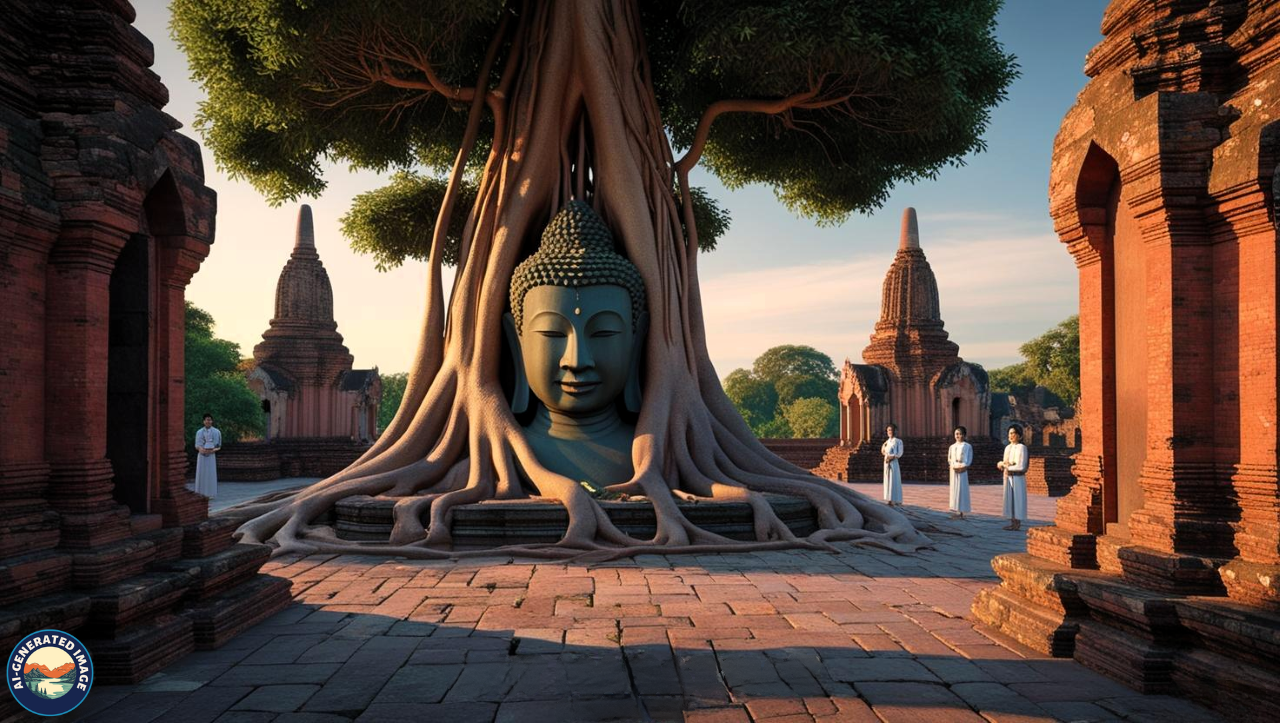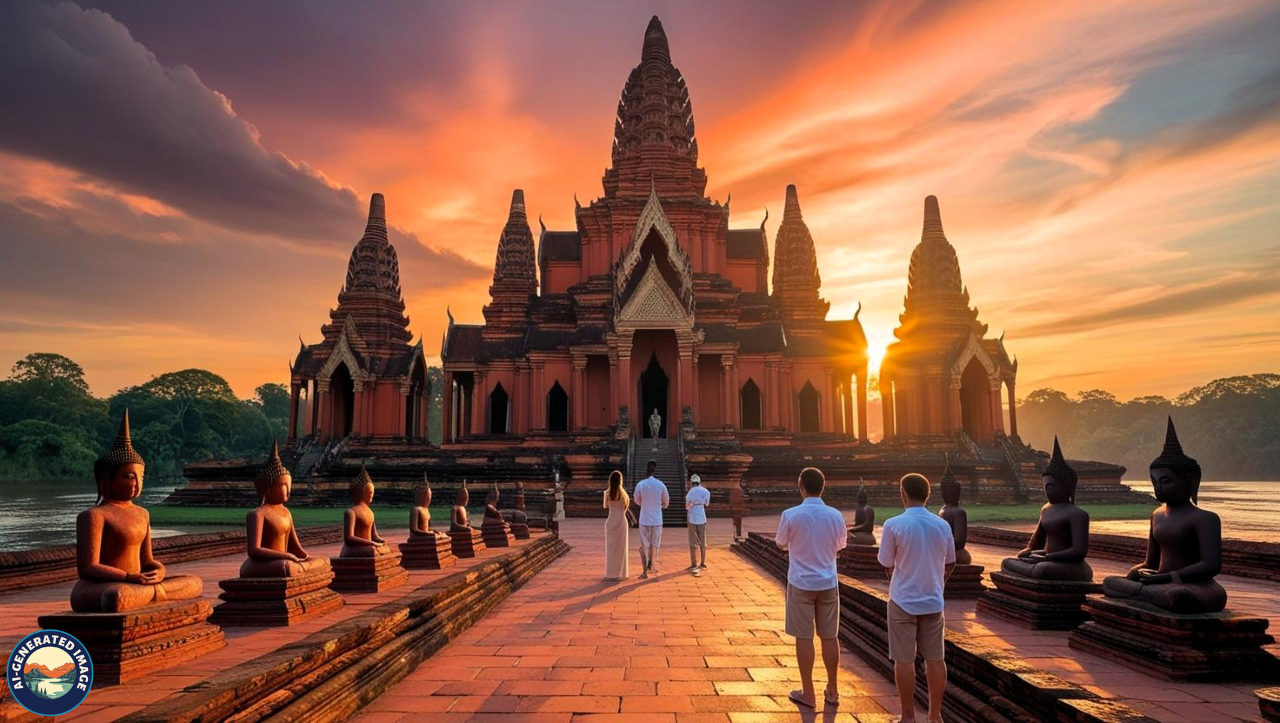Introduction
Imagine standing among towering ruins of ancient temples, where golden spires once touched the sky and serene Buddha statues silently watch over the remnants of a once-glorious empire. Welcome to Ayutthaya, the ancient capital of Siam and one of Southeast Asia’s greatest lost cities. Just a short trip north of Bangkok, Ayutthaya is a treasure trove of history, spirituality, and architectural wonders.
Founded in 1350, this UNESCO World Heritage Site tells the tale of a city that rose to be one of the wealthiest and most cosmopolitan places on Earth before being tragically sacked in 1767. Today, it offers visitors a chance to walk through history—among crumbling chedis (stupas), decaying prangs (towers), and peaceful statues that seem to whisper stories of the past.
In this post, we’ll take you through Ayutthaya’s fascinating history, must-see attractions, practical travel tips, local experiences, and more—perfect for history lovers, cultural explorers, and curious travelers alike.
History
The story of Ayutthaya begins in 1350, when King Ramathibodi I established the city as the new capital of the Kingdom of Siam. Strategically located at the confluence of three rivers—the Chao Phraya, Lopburi, and Pa Sak—Ayutthaya quickly flourished as a political, economic, and religious powerhouse.
By the 15th and 16th centuries, Ayutthaya had become one of the largest cities in the world, with a population exceeding one million. It was a magnet for international trade, attracting merchants from Persia, China, India, Japan, Portugal, France, and the Netherlands. Many foreign visitors compared it to cities like Venice or Paris, marveling at its wealth, palaces, and advanced urban planning.
Ayutthaya wasn’t just about trade; it was also a beacon of Buddhist culture and learning. The city was dotted with thousands of monasteries and temples, housing countless monks and scholars. Its architectural style—a fusion of Khmer, Sri Lankan, and Sukhothai influences—gave rise to iconic monuments that remain awe-inspiring even in ruin.
Tragically, in 1767, after a prolonged siege, the Burmese army invaded Ayutthaya. The city was looted, burned, and nearly flattened. Thousands were killed or enslaved, and the capital was relocated to what is now Bangkok. Despite this devastation, Ayutthaya’s spirit lives on in its ruins, now preserved as a national park.
Top Historical Sites to Explore
Wat Mahathat
One of the most iconic and photographed sites in Ayutthaya, Wat Mahathat, is famous for the Buddha head entwined in the roots of a Bodhi tree. But there’s more to this temple than this mystical image. Once a major royal monastery, Wat Mahathat served as the religious heart of the city.

Its central prang, now partially collapsed, was once a towering beacon of Ayutthaya’s spiritual might. Visitors can explore its courtyards, lined with rows of headless Buddha statues—eerie remnants of its destruction. Despite its ruined state, the temple exudes peace and dignity, offering an atmospheric glimpse into Ayutthaya’s past.
Wat Phra Si Sanphet
Situated within the old royal palace grounds, Wat Phra Si Sanphet was the most important temple of the Ayutthaya Kingdom. It was used exclusively by the royal family and did not house monks, which was unique at the time.

The temple is famous for its three towering chedis, which hold the ashes of Ayutthaya kings. These bell-shaped stupas, with their elegant proportions and striking silhouette, are among the most iconic images of the ancient city. Once gilded in gold, they must have been breathtaking in their original form. This temple also served as a model for Bangkok’s Wat Phra Kaew (Temple of the Emerald Buddha).
Wat Chaiwatthanaram
Located along the banks of the Chao Phraya River, Wat Chaiwatthanaram is one of Ayutthaya’s most photogenic temples. Built in 1630 by King Prasat Thong, it was designed in the Khmer style, inspired by Cambodia’s Angkor Wat.

Its central prang rises majestically above the surrounding chedis, all arranged symmetrically in a rectangular plan. This site is particularly stunning at sunset when golden light bathes the red-brick ruins. It’s an ideal spot for photos, reflection, or simply admiring ancient artistry.
Wat Lokayasutharam
A little off the beaten track, Wat Lokayasutharam is home to the giant reclining Buddha, measuring 42 meters in length and 8 meters in height. This enormous statue, depicting the Buddha in his final moments before entering Nirvana, is a powerful symbol of peace and impermanence.

Though the surrounding temple is in ruins, the statue remains a revered site. Visitors often leave offerings or incense at the Buddha’s feet. The relaxed atmosphere here makes it a nice contrast to the busier temples.
Ayutthaya Historical Park: What You Need to Know
The Ayutthaya Historical Park is a vast archaeological zone that covers the heart of the old city. With dozens of restored and unrestored temples, it’s a paradise for history buffs and photographers alike.
Practical Info:
-
Entry fee:
-
Around 50 THB per temple (combo tickets available)
-
Opening hours:
-
Typically from 8 AM to 6 PM
-
Best time to visit:
-
Go early morning or late afternoon to avoid heat and crowds
How to explore:
-
Bicycle rental:
-
This is the most popular way to explore. Costs around 40–100 THB per day
-
Tuk-tuks:
-
For faster travel between distant sites
-
Walking:
-
Possible but tiring in the heat
-
Guided tours:
-
Great for learning deeper historical context
The park is spread out, so plan your route or pick a few key temples to focus on.
How to Reach
Ayutthaya is conveniently located just 80 km north of Bangkok, making it perfect for a day trip or overnight stay.
Transport Options:
-
Train:
-
Departs from Bangkok’s Hua Lamphong station; takes 1.5–2.5 hours. Scenic and budget-friendly.
-
Minivan or bus:
-
Available from Bangkok’s Mo Chit Bus Terminal. Quick and affordable.
-
Private taxi or Grab:
-
This is more comfortable but pricier.
-
Boat cruise:
-
A leisurely and scenic way to travel along the Chao Phraya River, often including lunch and temple tours.
Once in Ayutthaya, you can rent a bicycle, hire a tuk-tuk for the day, or join a local tour to explore the city.
Cultural Etiquette & Dress Code
Thailand is a deeply spiritual country, and respecting local customs is essential—especially in sacred places like Ayutthaya.
Tips for Respectful Visits:
-
Dress modestly:
-
Cover shoulders and knees when visiting temples
-
Remove shoes:
-
Before entering temple buildings
-
Don’t touch Buddha statues or climb on ruins for photos
-
Stay quiet and respectful, especially when monks or worshippers are present
Even if some sites seem abandoned or less maintained, they are still revered. A little mindfulness goes a long way.
Local Experiences & Food to Try
Beyond the ruins, Ayutthaya offers a taste of traditional Thai life, from local markets to unique cuisine.
Floating Markets:
-
Ayutthaya Floating Market:
-
A lively, tourist-friendly market with boat vendors, performances, and street food.
-
Bang Noi Floating Market:
-
This is Smaller and more authentic, and it is great for weekend visits.
Must-Try Local Dishes:
-
Roti Sai Mai:
-
A sweet Thai-style cotton candy wrapped in thin roti—Ayutthaya’s signature dessert.
-
Grilled river prawns:
-
Giant, juicy prawns served with spicy dipping sauce.
-
Boat noodles:
-
Flavor-packed bowls of soup served in small portions—eat several for a full meal!
Cultural Interactions:
-
Join a local cooking class
-
Visit a pottery village
-
Try your hand at traditional Thai dance or handicrafts
Learning a few Thai phrases like “Sawasdee ka/krap” (hello) or “Khop khun ka/krap” (thank you) is appreciated by locals and shows respect.
Where to Stay
Ayutthaya has a variety of accommodations to suit different budgets and travel styles.
Budget:
-
Hostels and guesthouses near the historical park
-
Prices as low as 300–600 THB per night
-
Many offer free bicycle rentals
Mid-range:
-
Riverside hotels and boutique lodges with Thai décor
-
Comfortable amenities with peaceful surroundings
Luxury:
-
Heritage resorts with pools, spas, and fine dining
-
Perfect for a romantic getaway or a peaceful retreat
Unique Stays:
-
Traditional Thai wooden houses or homestays
-
Offers a local and cultural experience
Day Trip vs Overnight Stay: What’s Better?
While Ayutthaya is doable as a day trip from Bangkok, staying overnight offers a richer experience.
Day Trip Pros:
-
Quick and efficient
-
Ideal for tight schedules
-
Plenty of guided tours available
Day Trip Cons:
-
Rushed temple visits
-
Miss sunrise/sunset and night markets
Overnight Stay Pros:
-
See temples in golden light (sunrise or sunset)
-
Explore at a relaxed pace
-
Enjoy night markets, riverside dining, and cooler evenings
If you have time, an overnight stay is highly recommended.
Sustainable Travel Tips
Help preserve Ayutthaya’s heritage by traveling responsibly.
Do’s:
-
Support local businesses, guides, and craftspeople
-
Use reusable water bottles
-
Stay on marked paths to protect ruins
-
Donate to preservation efforts when possible
Don’ts:
-
Don’t litter or leave graffiti
-
Don’t take “souvenirs” from temple grounds
-
Don’t feed or harass stray animals
Being a responsible tourist ensures that future generations can also enjoy this historical gem.
Conclusion
Ayutthaya is more than just ruins—it’s a living story of resilience, culture, and ancient splendor. From grand temples and golden Buddhas to riverside markets and peaceful sunsets, it offers something for every traveler.
Whether you’re a history nerd, a photographer, or a curious soul craving something beyond the usual tourist path, Ayutthaya is a destination that will stay with you. So, next time you’re in Thailand, carve out a day (or two) to step back in time and discover the soul of a forgotten kingdom.
FAQs
Is Ayutthaya worth visiting?
Yes! It’s one of Thailand’s most important historical sites, filled with ancient temples, cultural treasures, and serene beauty.
Can I visit Ayutthaya on a day trip from Bangkok?
Absolutely. It’s just 1.5–2 hours away by train or car. Though staying overnight offers a deeper, more relaxed experience.
What should I wear when visiting temples?
Wear modest clothing that covers your shoulders and knees. Light cotton is ideal for the heat.
What’s the best way to get around Ayutthaya?
Bicycles are popular and fun, but tuk-tuks or guided tours are great for longer distances or hot weather.
What’s the best time to visit?
From November to February, when the weather is cool and dry. Early morning or sunset is best for exploring ruins.

